
Information Systems
.pdf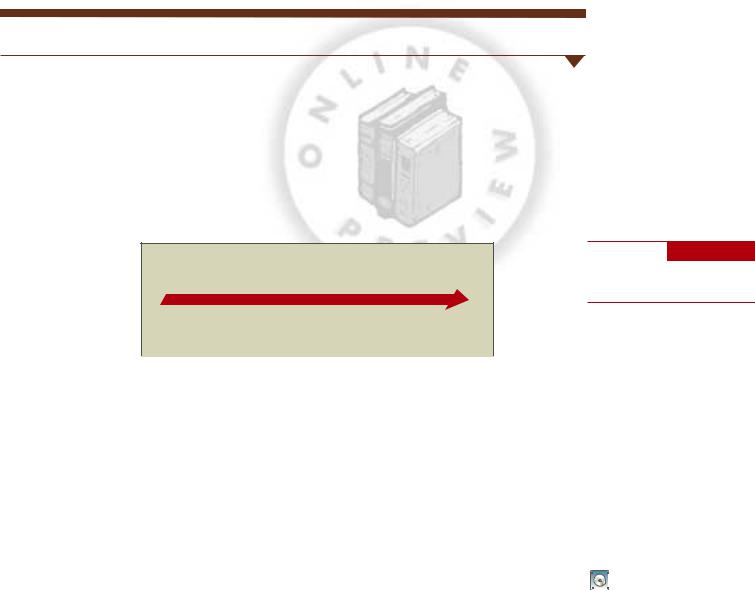
An Introduction to Information Systems | Chapter 1 |
21 |
|
People |
|
|
People are the most important element in most computer-based information systems. In- |
|
|
formation systems personnel include all the people who manage, run, program, and maintain |
|
|
the system. Large banks can hire hundreds of IS personnel to speed up the development of |
|
|
computer-related projects. Users are people who use information systems to get results. Users |
|
|
include financial executives, marketing representatives, manufacturing operators, and many |
|
|
others. Certain computer users are also IS personnel. |
|
|
Procedures |
|
|
Procedures include the strategies, policies, methods, and rules for using the CBIS. For |
procedures |
|
example, some procedures describe when each program is to be run or executed. Others |
The strategies, policies, methods, |
|
describe who can have access to facts in the database. Still other procedures describe what is |
and rules for using a CBIS. |
|
|
to be done in case a disaster, such as a fire, an earthquake, or a hurricane that renders the |
|
CBIS unusable. |
|
Now that we have looked at computer-based information systems in general, we will |
|
briefly examine the most common types used in business today. These IS types are covered |
|
in more detail in Part 3. |
|
BUSINESS INFORMATION SYSTEMS
The most common types of information systems used in business organizations are electronic and mobile commerce systems, transaction processing systems, management information systems, and decision support systems. In addition, some organizations employ special-pur- pose systems such as artificial intelligence systems, expert systems, and virtual reality systems. Together, these systems help employees in organizations accomplish both routine and special tasks—from recording sales, to processing payrolls, to supporting decisions in various departments, to providing alternatives for large-scale projects and opportunities. Figure 1.9 gives a simple overview of the development of important business information systems discussed in this section.
|
|
|
Electronic and |
TPS |
MIS |
DSS |
Mobile Commerce |
Figure 1.9
The Development of Important
Business Information Systems
1950s |
1960s |
1970s |
1980s |
1990s |
2000 and Beyond |
Electronic and Mobile Commerce
E-commerce involves any business transaction executed electronically between parties such as companies (business-to-business, B2B), companies and consumers (business-to-consumer, B2C), consumers and other consumers (consumer-to-consumer, C2C), business and the public sector, and consumers and the public sector. People may assume that e-commerce is reserved mainly for consumers visiting Web sites for online shopping. But Web shopping is only a small part of the e-commerce picture; the major volume of e-commerce—and its fastest-growing segment—is business-to-business (B2B) transactions that make purchasing easier for corporations. This growth is being stimulated by increased Internet access, growing user confidence, better payment systems, and rapidly improving Internet and Web security. Corporate Express, an office-supply company located in Broomfield, Colorado, uses a sophisticated B2B system to coordinate billions of dollars of office supplies that flow from its suppliers, through its offices, to its customers.27 Today, more than half of its 75,000 daily orders arrive electronically through B2B on the Internet. E-commerce offers opportunities for small businesses, too, by enabling them to market and sell at a low cost worldwide, thus
e-commerce
Any business transaction executed electronically between parties such as companies (business-to- business), companies and consumers (business-to-consumer), consumers and other consumers (consumer-to-consumer), business and the public sector, and consumers and the public sector.
Copyright © 2005 by Course Technology. All rights reserved.This publication is protected by federal copyright law. No part of this publication may be reproduced without prior permission in writing from Course Technology. Some of the product names and company names have been used for identification purposes only and may be trademarks or registered trademarks of their respective manufactures and sellers.

22 |
Part 1 | Information Technology Concepts |
IBM PartnerWorld® is an example of B2B (business-to-business) e-commerce that provides member companies with resources for product marketing, technical support and training.
mobile commerce (m-commerce)
Transactions conducted anywhere, anytime.
allowing them to enter the global market right from start-up. Mobile commerce (m-commerce) are transactions conducted anywhere, anytime. M-commerce relies on the use of wireless communications to allow managers and corporations to place orders and conduct business using handheld computers, portable phones, laptop computers connected to a network, and other mobile devices.
Consumers who have tried online shopping appreciate the ease of e-commerce. They can avoid fighting crowds in the malls, shop online at any time from the comfort of their home, and have goods delivered to them directly. As a result, advertisers plan to increase spending by 6.3 percent online versus 4.7 percent in conventional media.28 In addition, current laws governing online purchases exempt purchasers from paying state sales taxes. However, e- commerce is not without its downside. Consumers continue to have concerns about sending credit card information over the Internet to sites with varying security measures, where hightech criminals could obtain it. In addition, denial-of-service attacks that overwhelm the capacity of some of the Web’s most established and popular sites have raised new concerns for continued growth of e-commerce. Privacy is an additional concern. Individuals want to know what data is gathered when a consumer visits a Web site and what companies do with the collected data; some have sold data to multiple sources, leading marketing companies to know more than we would like. See the “Ethical and Societal Issues” box, which discusses other potential problems of e-commerce.
Copyright © 2005 by Course Technology. All rights reserved.This publication is protected by federal copyright law. No part of this publication may be reproduced without prior permission in writing from Course Technology. Some of the product names and company names have been used for identification purposes only and may be trademarks or registered trademarks of their respective manufactures and sellers.

ETHICAL AND
SOCIETAL ISSUES
Phishing for Visa Card Customers
A new type of Internet fraud is becoming increasingly prevalent— and costing consumers their money and identity. This latest scam is called phishing because it uses e-mail and Web sites as bait to lure consumers into revealing private information.
E-commercesystemsrely onthetrustofthe participants. Ifthey do not trustthe technology to provide safe and secure transactions, e-commerce would have no future. While network research has produced more secure connections between two parties over the Internet, no foolproof systems exist to guarantee that the participants are who they claim to be. Phishing scams exploit this system vulnerability.
A phishing scam was recently launched against Visa card customers and serves as a textbook example of the technique. A masse-mail was sentto Internet users with an official-looking Visa return address, claiming to have come from Visa International Services. Sending e-mail with a forged returnaddress is a common practice inInternetfraud and isformally referredtoasspoofing.The e-mail stated that Visa had implemented a new “security system to help you to avoid possible fraud actions” and asked users to click a link to “reactivate your account.” The link was printed as www.visa. com, but when users clicked the link, it took them to a Web site that resembled the Visa Web site—withan officialVisa logo,artwork,and design—but was not owned by Visa. The site asked customers to enterpersonal information, including their Visa creditcard number. The scam artists then had both a customer’s account number and his or her name.
The 2003 holiday season saw a 400percent increase inphishing scams, with 60 unique attacks launched and more than 60 million fraudulent e-mails sent out. It is estimated that 5 to 20 percent of recipients respond to phishing scams. Inthe Visa scam, the owners of the fraudulent site shut down and disappeared prior to discovery, taking with them an unknown quantity of customer records. The information they stole could be sold in the underground credit card marketand used by crooksand thievesto assume theidentity of the victims and make illegal purchases.
Phishing scams are increasingly difficult to detect. The fraudulente-mailsand Web siteslook identicalto originalcorporate correspondence and Web sites. Web addresses appear legitimate and may even employ secure connections (identified by the closed-lock icon atthe bottom of the browser window). Suchscams make it difficult for legitimate businesses to communicate
electronically with their customers and to conduct business online. “At stake is our very trust that the Internet can be relied upon for safe and secure commerce and communications,” says Dave Jevans, chairman of the Anti-Phishing Working Group (www.antiphishing.org).
Software tools designed to detect phishing scams typically identify only 50 to 70 percentof all phony systems. The only defense consumershave againstsuchscamsiseducation—and caution. Be leery of any e-mail from a company thatasksyouto visita Web page to provide private information. Check withthe company at its official Web site to confirm that such requests are legitimate before complying.
Critical Thinking Questions
1.How can people protect themselves from becoming a victim of a phishing scam?
2.What action can people take if they discover that their private information has been stolen?
What Would You Do?
You’ve received an e-mail from your college’s Financial Aid Department that congratulates you on being the recipient of funds from a newly launched grant program. To receive your $2,000 for this semester, you are required to visit the Financial Aid Web site (www.financial-aid.yourschool.com) and submit a brief online applicationform.Afterfilling outtheform,whichcollectsinformation such asyour name, address,phone, date ofbirth,schoolID number, Social Security number, and bank-account number (for automatic deposit), you click the Submitbutton and head outto celebrate your good fortune. After a week, the money has yet to be deposited, and you are getting concerned.
3.What in this scenario suggests that this might be a phishing scam?
4.If you were responsible for information security at your school, what system might you design to assure students that official school correspondence really comes from the school and not from an imposter?
SOURCES: Paul Roberts, “Latest ’Phishing’ Scam Targets Visa Customers,” Computerworld, December 26, 2003; “Growth in Internet Fraud to Be Key Concern In 2004,” Electronic Commerce News, January 5, 2004; the Anti-Phishing group Web site, www.anti-phishing.org, accessed January 17, 2004.
Copyright © 2005 by Course Technology. All rights reserved.This publication is protected by federal copyright law. No part of this publication 23 may be reproduced without prior permission in writing from Course Technology. Some of the product names and company names have been
used for identification purposes only and may be trademarks or registered trademarks of their respective manufactures and sellers.
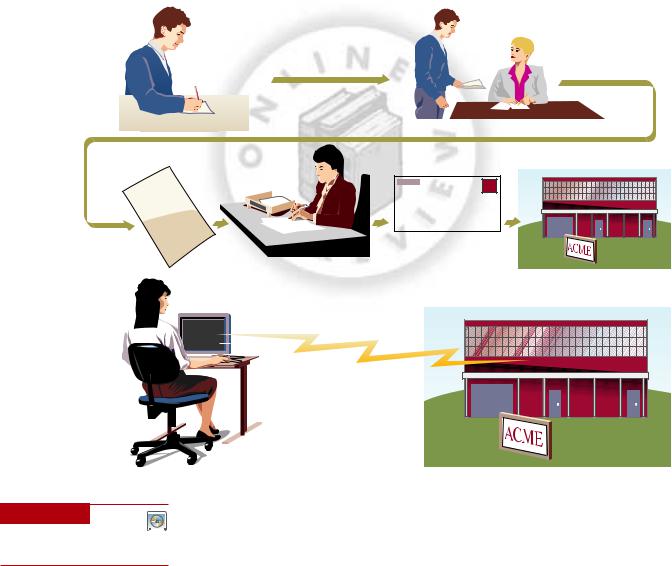
24 |
Part 1 | Information Technology Concepts |
Yet, in spite of the concerns, e-commerce offers many advantages for streamlining work activities. Figure 1.10 provides a brief example of how e-commerce can simplify the process for purchasing new office furniture from an office-supply company. Under the manual system, a corporate office worker must get approval for a purchase that costs more than a certain amount. That request goes to the purchasing department, which generates a formal purchase order to procure the goods from the approved vendor. Business-to-business e-commerce automates the entire process. Employees go directly to the supplier’s Web site, find the item in its catalog, and order what they need at a price set by the employee’s company. If approval is required, the approver is notified automatically. As the use of e-commerce systems grows, companies are phasing out their traditional systems. The resulting growth of e-commerce is creating many new business opportunities.
E-commerce can have a positive impact on stock prices and the market value of firms. Today, several e-commerce firms have teamed up with more traditional brick-and-mortar firms to draw from each other’s strengths. Some e-commerce customers can order products through an Internet site and pick them up at a local store close by.
Requisition
|
er |
|
h |
|
|
|
|
|
|
|
|
|
rd |
|
|
|
|
|
|
|
|
||
|
O |
|
ac |
|
|
|
|
|
|
|
|
se |
|
e |
|
|
|
|
|
|
|
|
|
ha |
|
ne |
|
|
|
|
|
|
|
|
|
rc |
o |
|
|
|
|
|
|
|
|
|
|
u |
us |
|
g |
|
|
|
|
|
|
|
|
P |
d |
|
|
|
s |
|
|
|
|
|
|
en |
|
in |
|
|
|
|
|
|
|
||
s |
|
ow |
|
le |
|
|
|
|
|
||
se |
ll |
|
p |
od |
|
|
|
||||
a |
fo |
|
’sta |
|
|
|
|
|
|||
ple |
|
|
/4 |
|
lywo |
|
|
|
|||
ofthe |
|
3 |
|
|
|
|
|||||
|
|
of |
ep |
ws |
|
|
|
||||
0boxes DX |
|
|
ll |
|
s |
|
|
|
|||
|
|
|
pin |
|
|
re |
|
|
|
||
|
|
|
|
sc |
|
|
|
||||
10 |
|
C |
drywa |
|
ge |
|
|
|
|||
|
ets |
hin |
|
|
|
||||||
|
e |
|
k |
|
|
|
|
|
|
||
sh |
|
c |
|
|
uty |
|
|
|
|||
2 |
.Bla |
vy |
|
|
|
|
|
||||
4 |
|
|
|
|
d |
|
|
|
|
|
|
|
Ibs |
|
|
a |
|
|
|
|
|
|
|
10 |
|
aHe |
|
|
|
|
|
|
|
||
|
Extr |
|
|
|
|
|
|
|
|
||
|
47 |
|
|
|
|
|
|
|
|
|
|
|
|
|
|
|
|
|
|
|
|
|
|
|
|
|
|
|
|
|
|
|
|
|
|
|
|
|
|
|
|
|
|
|
|
|
|
|
|
|
|
|
|
|
|
|
|
|
|
|
|
|
|
|
|
|
|
|
|
|
|
|
Obtain |
|
approval of |
Prepare |
requisition |
|
|
requisition |
|
Purchasing |
|
department |
Vendor |
Inbox
ACME Inc.
7 That St.
Anywhere, USA
01800
Traditional process for placing a purchase order
Vendor
Electronic purchase order
Figure 1.10
E-Commerce Greatly
Simplifies Purchasing
E-commerce process for placing a purchase order
In addition to e-commerce, business information systems include the use of telecommunications and the Internet to perform many related tasks. Electronic procurement (e-procure- ment), for example, involves using information systems and the Internet to acquire parts and supplies using information systems and the Internet. Electronic business (e-business) goes beyond e-commerce to include the use of information systems and the Internet to perform all business-related tasks and functions, such as accounting, finance, marketing, manufacturing, and human resources activities. Electronic management (e-management) involves the use of
Copyright © 2005 by Course Technology. All rights reserved.This publication is protected by federal copyright law. No part of this publication may be reproduced without prior permission in writing from Course Technology. Some of the product names and company names have been used for identification purposes only and may be trademarks or registered trademarks of their respective manufactures and sellers.
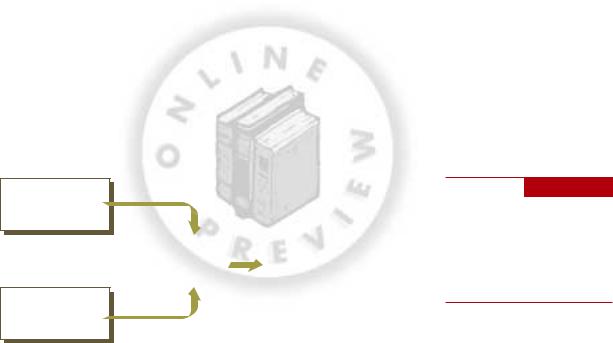
An Introduction to Information Systems | Chapter 1 |
25 |
information systems and the Internet to manage profit and nonprofit organizations, including governmental agencies, the military, and religious and charitable organizations. E-management includes all aspects of staffing and hiring, directing, controlling, and other management tasks.
Transaction Processing Systems and Enterprise
Resource Planning
Transaction Processing Systems
Since the 1950s computers have been used to perform common business applications. The objective of many of these early systems was to reduce costs by automating many routine, labor-intensive business systems. A transaction is any business-related exchange such as payments to employees, sales to customers, or payments to suppliers. Thus, processing business transactions was the first application of computers for most organizations. A transaction processing system (TPS) is an organized collection of people, procedures, software, databases, and devices used to record completed business transactions. To understand a transaction processing system is to understand basic business operations and functions.
One of the first business systems to be computerized was the payroll system (see Figure 1.11). The primary inputs for a payroll TPS are the numbers of employee hours worked during the week and pay rate. The primary output consists of paychecks. Early payroll systems were able to produce employee paychecks, along with important employee-related reports required by state and federal agencies, such as the Internal Revenue Service. Other routine applications include sales ordering, customer billing and customer relationship management, inventory control, and many other applications. Some automobile companies, for example, use their TPS to buy billions of dollars of needed parts each year through Internet sites. Because these systems handle and process daily business exchanges, or transactions, they are all classified as TPSs.
Hours worked
|
Payroll |
|
|
Payroll |
|
|
|
|
|
||
|
transaction |
|
|
|
|
|
|
|
checks |
|
|
|
processing |
|
|
|
|
|
|
|
|
|
|
|
|
|
|
|
|
Pay rate
transaction
Any business-related exchange, such as payments to employees, sales to customers, and payments to suppliers.
Transaction processing system (TPS)
An organized collection of people, procedures, software, databases, and devices used to record completed business transactions.
Figure 1.11
A Payroll Transaction
Processing System
The inputs (numbers of employee hours worked and pay rates) go through a transformation process to produce outputs (paychecks).
In improved forms, these TPSs are still vital to most modern organizations: Consider what would happen if an organization had to function without its TPS for even one day. How many employees would be paid and paid the correct amount? How many sales would be recorded and processed? Transaction processing systems represent the application of information concepts and technology to routine, repetitive, and usually ordinary business transactions that are critical to the daily functions of that business.
Enterprise Resource Planning
An enterprise resource planning (ERP) system is a set of integrated programs that is capable of managing a company’s vital business operations for an entire multisite, global organization. ERP systems can replace many applications with one unified set of programs. Sutter Health, a large network of 33 hospitals with over 4 million patients in northern California, uses an ERP system to process medical transactions and to exchange information between hospitals, physicians, and employees.29 Although the scope of an ERP system may vary from company to company, most ERP systems provide integrated software to support the manufacturing and finance business functions of an organization. In such an environment, a forecast is prepared that estimates customer demand for several weeks. The ERP system checks what is
enterprise resource planning (ERP) system
A set of integrated programs capable of managing a company’s vital business operations for an entire multisite, global organization.
Copyright © 2005 by Course Technology. All rights reserved.This publication is protected by federal copyright law. No part of this publication may be reproduced without prior permission in writing from Course Technology. Some of the product names and company names have been used for identification purposes only and may be trademarks or registered trademarks of their respective manufactures and sellers.

26 |
Part 1 | Information Technology Concepts |
SAP AG, a German software company, is one of the leading suppliers of ERP software. The company employs nearly 30,000 people in more than 50 countries.
management information system (MIS)
An organized collection of people, procedures, software, databases, and devices used to provide routine information to managers and decision makers.
already available in finished product inventory to meet the projected demand. Manufacturing must then produce inventory to eliminate any shortcomings. In developing the production schedule, the ERP system checks the raw-material and packing-material inventories and determines what needs to be ordered to meet the schedule. Most ERP systems also have a purchasing subsystem that orders the needed items. In addition to these core business processes, some ERP systems can support additional business functions, such as human resources, sales, and distribution. Customer relationship management (CRM) features, for example, help organizations manage all aspects of customer interactions, including inquiries, sales, delivery of products and services, and support after the sale. Today, ERP companies have Internet-based systems to manage customer relationships. The primary benefits of implementing an ERP system include easing adoption of improved work processes and improving access to timely data for decision making. An ERP system can take a large number of separate systems developed over a number of years by an organization and replace them with one unified set of programs, making the system easier to use and more effective.
Information and Decision Support Systems
The benefits provided by an effective TPS are tangible and justifies their associated costs in computing equipment, computer programs, and specialized personnel and supplies. They speed business activities and reduce clerical costs. Although early accounting and financial TPSs were already valuable, companies soon realized that the data stored in these systems could be used to help managers make better decisions in their respective business areas, whether human resource management, marketing, or administration. Satisfying the needs of managers and decision makers continues to be a major factor in developing information systems.
Management Information Systems
A management information system (MIS) is an organized collection of people, procedures, software, databases, and devices used to provide routine information to managers and decision makers. The focus of an MIS is primarily on operational efficiency. Marketing, production, finance, and other functional areas are supported by MISs and linked through a common database. Management information systems typically provide standard reports generated with data and information from the TPS (see Figure 1.12).
Management information systems were first developed in the 1960s and are characterized by the use of information systems to produce managerial reports. In most cases, these early reports were produced periodically—daily, weekly, monthly, or yearly. Gambling casinos generate daily reports that tell their staff what specific customers like. Some casinos know
Copyright © 2005 by Course Technology. All rights reserved.This publication is protected by federal copyright law. No part of this publication may be reproduced without prior permission in writing from Course Technology. Some of the product names and company names have been used for identification purposes only and may be trademarks or registered trademarks of their respective manufactures and sellers.
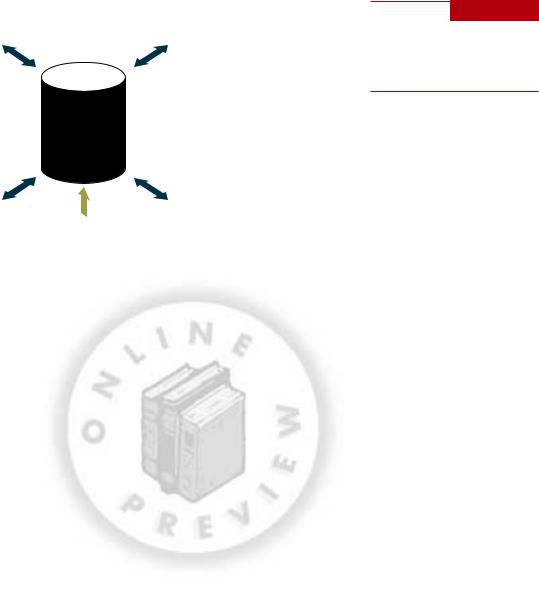
An Introduction to Information Systems | Chapter 1 |
27 |
MARKETING |
MANUFACTURING |
MANAGEMENT |
MANAGEMENT |
INFORMATION |
INFORMATION |
SYSTEM |
SYSTEM |
Common
Database
FINANCIAL |
|
OTHER |
MANAGEMENT |
TPS |
MANAGEMENT |
INFORMATION |
INFORMATION |
|
SYSTEM |
|
SYSTEMS |
whether a certain customer likes flowers in her room or a beverage in his hand and can accommodate individual needs or desires. Periodic reports are printed regularly, so they are called scheduled reports. Scheduled reports help managers perform their duties. For example, a summary report of total payroll costs might help an accounting manager control future payroll costs. Because of their value to managers, MISs have proliferated throughout the management ranks. For instance, the total payroll summary report produced initially for an accounting manager might also be useful to a production manager to help monitor and control labor and job costs. Other scheduled reports are used to help managers from a variety of departments control customer credit, payments to suppliers, the performance of sales representatives, inventory levels, and more.
Other types of reports were also developed during the early stages of MISs. Demand reports were developed to give decision makers certain information on request. For example, prior to closing a sale, a sales representative might seek a demand report on how much inventory exists for a particular item. This report would tell the representative whether enough inventory is on hand to fill the customer’s order. Exception reports describe unusual or critical situations, such as low inventory levels. An exception report is produced only if a certain condition exists—in this case, inventory falling below a specified level. For example, in a bicycle manufacturing company, an exception report might be produced by the MIS if the number of bicycle seats is too low and more should be ordered.
Decision Support Systems
By the 1980s, dramatic improvements in technology resulted in information systems that were less expensive but more powerful than earlier systems. People at all levels of organizations began using personal computers to do a variety of tasks; they were no longer solely dependent on the IS department for all their information needs. So, people quickly recognized that computer systems could support additional decision-making activities. A decision support system (DSS) is an organized collection of people, procedures, software, databases, and devices used to support problem-specific decision making. The focus of a DSS is on decisionmaking effectiveness. Whereas an MIS helps an organization “do things right,” a DSS helps a manager “do the right thing.” Oxford Bookstore, located in Calcutta, uses a DSS and the Internet to allow book lovers in India to purchase their favorite books at Oxford’s traditional retail stores or through its Internet site. The Internet site provides a wealth of information to help people make better book-purchasing decisions.30 Blue Cross of Pennsylvania uses a DSS from InterQual to help it support level-of-care decisions.31
A DSS supports and assists all aspects of problem-specific decision making. A DSS can also support customers by rapidly responding to their phone and e-mail inquiries. A DSS goes beyond a traditional MIS by providing immediate assistance in solving complex problems. Many of these problems are unique and not straightforward, and information is often difficult to obtain. For instance, an auto manufacturer might try to determine the best location to build a new manufacturing facility, or an oil company might want to discover
Figure 1.12
Functional management information systems draw data from the organization’s transaction processing system.
decision support system (DSS)
An organized collection of people, procedures, software, databases, and devices used to support prob- lem-specific decision making.
Copyright © 2005 by Course Technology. All rights reserved.This publication is protected by federal copyright law. No part of this publication may be reproduced without prior permission in writing from Course Technology. Some of the product names and company names have been used for identification purposes only and may be trademarks or registered trademarks of their respective manufactures and sellers.
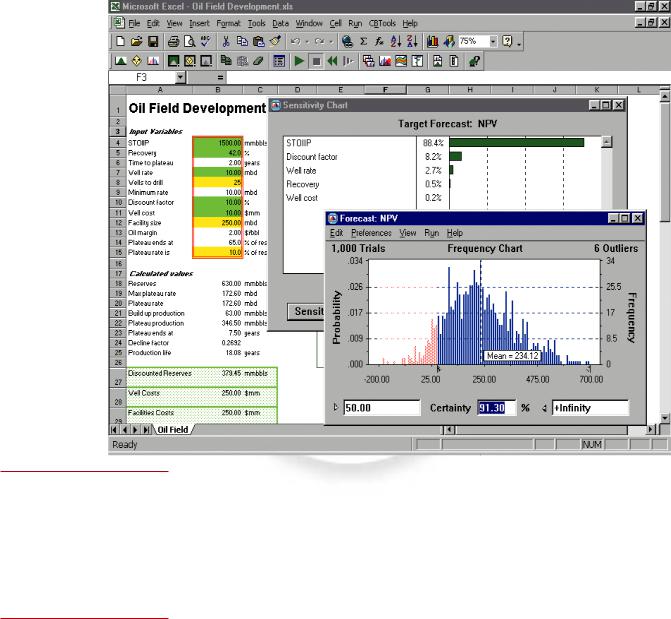
28 |
Part 1 | Information Technology Concepts |
Decisioneering provides decision support software called Crystal Ball, which helps business people of all types assess risks and make forecasts. Shown here is the Standard Edition being used for oil field development.
(Source: Crystal Ball screenshot courtesy of Decisioneering, Inc.)
the best place to drill for oil. Some big oil companies use a DSS to track and manage projects and employees in countries around the world. Traditional MISs are seldom used to solve these types of problems; a DSS can help by suggesting alternatives and assisting in final decision making.
Decision support systems are used when the problem is complex and the information needed to make the best decision is difficult to obtain and use. So, a DSS also involves managerial judgment and perspective. Managers often play an active role in the development and implementation of the DSS. A DSS recognizes that different managerial styles and decision types require different systems. For example, two production managers in the same position trying to solve the same problem might require different information and support. The overall emphasis is to support, rather than replace, managerial decision making.
The essential elements of a DSS include a collection of models used to support a decision maker or user (model base), a collection of facts and information to assist in decision making (database), and systems and procedures (dialogue manager) that help decision makers and other users interact with the DSS (see Figure 1.13). Software is often used to manage the database (the database management system, DBMS) and the model base (the model management system, MMS).
In addition to DSSs that support individual decision making, there are group decision support systems and executive support systems that use the same overall approach of a DSS. A group decision support system, also called a group support system, includes the DSS elements just described and software, called groupware, to help groups make effective decisions. An executive support system, also called an executive information system, helps top-level managers, including a firm’s president, vice presidents, and members of the board of directors, make better decisions. An executive support system can be used to assist with strategic planning, top-level organizing and staffing, strategic control, and crisis management.
Copyright © 2005 by Course Technology. All rights reserved.This publication is protected by federal copyright law. No part of this publication may be reproduced without prior permission in writing from Course Technology. Some of the product names and company names have been used for identification purposes only and may be trademarks or registered trademarks of their respective manufactures and sellers.
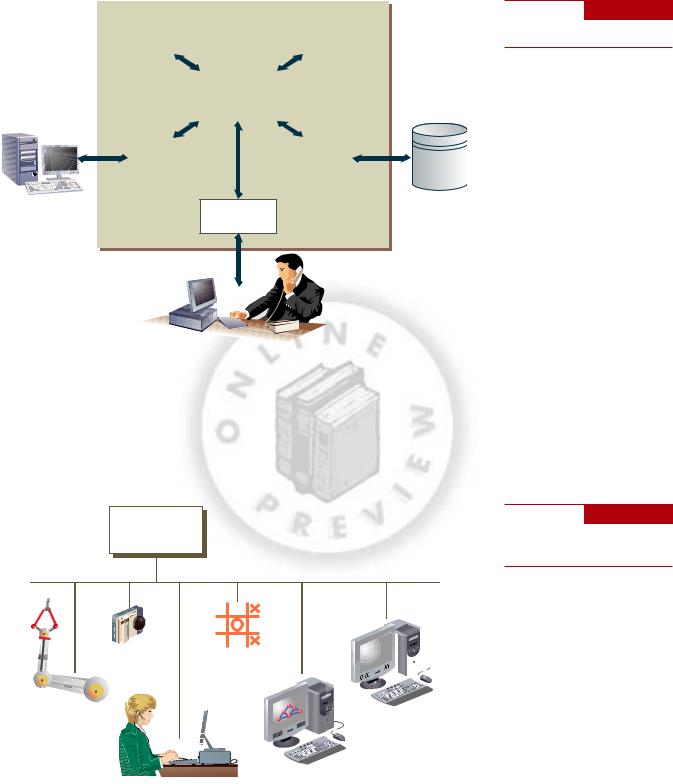
An Introduction to Information Systems | Chapter 1 |
29 |
Database |
|
Model base |
|
|
|
|
|
DBMS |
MMS |
|
|
|
|
|
|
|
|
|
|
|
|
|
|
Access to the Internet, |
|
|
External |
|
|
corporate intranets, |
|
|
|
||
|
|
database |
External |
||
extranets, networks, |
|
|
|||
|
|
access |
|||
and other computer |
|
|
database |
||
|
|
|
|||
systems |
|
|
|
|
|
|
|
|
|
||
Figure 1.13
Essential DSS Elements
Dialogue manager
Specialized Business Information Systems: Artificial Intelligence, Expert Systems, and Virtual Reality
In addition to TPSs, MISs, and DSSs, organizations often use specialized systems. One of these systems is based on the notion of artificial intelligence (AI), where the computer system takes on the characteristics of human intelligence. The field of artificial intelligence includes several subfields (see Figure 1.14).
Artificial intelligence
artificial intelligence (AI)
A field in which the computer system takes on the characteristics of human intelligence.
Figure 1.14
TheMajorElements of Artificial
Intelligence
|
|
|
|
|
|
|
|
|
|
|
|
|
|
|
|
|
|
|
Vision |
Learning |
|
|
|
|||
|
systems |
|
|
|
||||
|
systems |
|
|
|
||||
|
|
|
|
|
|
|
|
|
Robotics |
|
|
|
|
Expert systems |
|||
|
|
|
|
|
||||
|
|
|
|
|
Neural networks |
|||
|
|
Natural language |
|
|
|
|
||
|
|
processing |
|
|
|
|
||
Copyright © 2005 by Course Technology. All rights reserved.This publication is protected by federal copyright law. No part of this publication may be reproduced without prior permission in writing from Course Technology. Some of the product names and company names have been used for identification purposes only and may be trademarks or registered trademarks of their respective manufactures and sellers.

30 |
Part 1 | Information Technology Concepts |
||
|
|
Artificial Intelligence |
|
|
|
Robotics is an area of artificial intelligence in which machines take over complex, dangerous, |
|
|
|
routine, or boring tasks, such as welding car frames or assembling computer systems and |
|
|
|
components. Vision systems allow robots and other devices to see, store, and process visual |
|
|
|
images. Natural language processing involves the ability of computers to understand and act |
|
|
|
on verbal or written commands in English, Spanish, or other human languages. Learning |
|
|
|
systems give computers the ability to learn from past mistakes or experiences, such as playing |
|
|
|
games or making business decisions, and neural networks is a branch of artificial intelligence |
|
|
|
that allows computers to recognize and act on patterns or trends. Some successful stock, |
|
|
|
options, and futures traders use neural networks to spot trends and make them more |
|
|
|
profitable with their investments. |
|
|
|
Expert Systems |
|
expert system |
Expert systems give the computer the ability to make suggestions and act like an expert in |
||
A system that gives a computer the |
a particular field. The unique value of expert systems is that they allow organizations to |
||
ability to make suggestions and act |
capture and use the wisdom of experts and specialists. Therefore, years of experience and |
||
like an expert in a particular field. |
|||
specific skills are not completely lost when a human expert dies, retires, or leaves for another |
|||
|
|
||
|
|
job. Expert systems can be applied to almost any field or discipline. Expert systems have been |
|
|
|
used to monitor complex systems such as nuclear reactors, perform medical diagnoses, locate |
|
|
|
possible repair problems, design and configure IS components, perform credit evaluations, |
|
|
|
and develop marketing plans for a new product or new investment strategies. The collection |
|
|
|
of data, rules, procedures, and relationships that must be followed to achieve value or the |
|
knowledge base |
proper outcome is contained in the expert system’s knowledge base. |
||
The collection of data, rules, proce- |
The end of the twentieth century brought advances in both artificial intelligence and |
||
dures, and relationships that must |
expert systems. More and more organizations are using these systems to solve complex prob- |
||
be followed to achieve value or the |
|||
lems and support difficult decisions. However, many issues remain to be resolved, and more |
|||
proper outcome. |
|||
work is needed to refine their meaningful uses. |
|||
|
|
||
|
|
Virtual Reality |
|
virtual reality |
Virtual reality is the simulation of a real or imagined environment that can be experienced |
||
The simulation of a real or imagined |
visually in three dimensions. Originally, virtual reality referred to immersive virtual reality, |
||
environment that can be experi- |
which means the user becomes fully immersed in an artificial, 3-D world that is completely |
||
|
|
||
enced visually in three dimensions.
generated by a computer. The virtual world is presented in full scale and relates properly to the human size. It may represent any 3-D setting, real or abstract, such as a building, an archaeological excavation site, the human anatomy, a sculpture, or a crime scene reconstruction. Virtual worlds can be animated, interactive, and shared. Through immersion, the user can gain a deeper understanding of the virtual world’s behavior and functionality.
A variety of input devices such as head-mounted displays (see Figure 1.15), data gloves (see Figure 1.16), joysticks, and handheld wands allow the user to navigate through a virtual environment and to interact with virtual objects. Directional sound, tactile and force feedback devices, voice recognition, and other technologies are used to enrich the immersive experience. Several people can share and interact in the same environment. Because of this ability, virtual reality can be a powerful medium for communication, entertainment, and learning.
Virtual reality can also refer to applications that are not fully immersive, such as mousecontrolled navigation through a 3-D environment on a graphics monitor, stereo viewing from the monitor via stereo glasses, stereo projection systems, and others. Some virtual reality applications allow views of real environments with superimposed virtual objects. Motion trackers monitor the movements of dancers or athletes for subsequent studies in immersive virtual reality. Telepresence systems (e.g., telemedicine, telerobotics) immerse a viewer in a real world that is captured by video cameras at a distant location and allow for the remote manipulation of real objects via robot arms and manipulators. Many believe that virtual reality is reshaping the interface between people and information technology by offering new ways to communicate information, visualize processes, and express ideas creatively.
Useful applications of virtual reality include training in a variety of areas (military, medical, equipment operation, etc.), education, design evaluation (virtual prototyping), architectural walk-throughs, human factors and ergonomic studies, simulation of assembly sequences and maintenance tasks, assistance for the handicapped, study and treatment of
Copyright © 2005 by Course Technology. All rights reserved.This publication is protected by federal copyright law. No part of this publication may be reproduced without prior permission in writing from Course Technology. Some of the product names and company names have been used for identification purposes only and may be trademarks or registered trademarks of their respective manufactures and sellers.
